
Guests
- Paul Demkoreporter with the Minnesota Independent.
- Shannyn Moorejournalist and former radio talk show host who closely follows Alaska politics. She blogs at Shannynmoore.wordpress.com
Three Senate races still hang in the balance — Georgia, Alaska and Minnesota — with a filibuster-proof, sixty-seat Democratic supermajority at stake. We get reports from Anchorage and Minneapolis. [includes rush transcript]
Transcript
JUAN GONZALEZ: Control of the US Senate hangs in the balance with three races still too close to call. Democrats picked up six seats on November 4th, building up a commanding advantage to currently control fifty-seven Senate seats to forty for the Republicans. But three key races — in Minnesota, Alaska and Georgia — are still not certain, and they could open the door to a filibuster-proof, sixty-seat “supermajority” for the Democrats.
In Georgia, incumbent Republican Senator Saxby Chambliss fell short of winning the 50 percent of the vote required for election under Georgia law. He faces a runoff against former Democratic state legislator Jim Martin on December 2nd.
In Alaska, Senator Ted Stevens, the longest-serving Republican in Senate history, leads former Anchorage mayor, Democrat Mark Begich, by just over 3,000 votes, with about 30 percent of the ballots remaining to be counted. Stevens faces potential expulsion proceedings after his conviction last month of seven felonies connected to lies on financial disclosure forms. A final vote count is expected next Wednesday.
And in Minnesota, the race between incumbent Republican Norm Coleman and Democratic challenger Al Franken is the closest in the country. As of Monday, Coleman leads Franken by a razor-thin 206 votes out of 2.9 million ballots cast. When certified, the result will lead to an automatic recount, which state law says is triggered if the margin of victory is less than half of one percent.
AMY GOODMAN: Today we’re going to focus on two of the races: in Minnesota and Alaska. Paul Demko is a reporter with the Minnesota Independent. He joins us via internet video stream from Minneapolis. And we’re joined on the phone from Anchorage by Shannyn Moore, journalist and former radio talk show host, who closely follows Alaska politics.
OK, Shannyn, we’re going to go to you first in Anchorage. How is it possible that Alaska still has a third — basically a third of the ballots not yet counted, with — I guess it’s Senator Stevens now up by 3,000 votes with the two-thirds that are counted?
SHANNYN MOORE: Good morning, Amy and Juan. It is difficult for many of us to sort of figure that out, and it’s sort of creating a stir around here. There was a remarkable early voter turnout, and we think that most of that was, you know, counted with the ballots on the night, election night. But then an additional about — I think about 9,000 showed up there. And then, what’s curious about this race is that 92 percent, so far, of the people who filed for absentee voting turned their ballots back in, which is a remarkable number. Every couple days they’re finding 10,000 votes. And what’s remarkable about that, you know, 2004, I think only 54 percent turned theirs in.
JUAN GONZALEZ: Now, initially, the polls showed Senator Stevens trailing badly, and yet the count now shows him with a slight lead. Concerns about that, as well?
SHANNYN MOORE: Well, certainly. You know, all of our polls have been remarkably off. Don Young and Ethan Berkowitz — Ethan Berkowitz was, I think, eight and twelve points ahead of Don Young consistently through the whole race, and now he’s eight points behind. So, you know, you’re seeing these sixteen-point swings. Also, this would be the second-lowest voter turnout in Alaska history, percentage-wise. And there’s just a whole lot of issues. Basically, you have to believe that the 21,000 people who registered to vote in the last four years decided to stay home and that people who did come out and vote for George Bush didn’t feel like coming out for Sarah Palin, and people that came out for John Kerry stayed home and didn’t vote for Barack Obama, because there’s less votes.
AMY GOODMAN: Now, Begich was up in the pre-polling at something like 29 percent, the mayor of Anchorage — 29 percent. Nate Silver, who does fivethirtyeight.org, who’s been remarkably prescient in almost all of — dotcom — in almost all of the other races, had this one for Begich 100 percent.
SHANNYN MOORE: Right, he did. And he has been remarkably accurate. And I can tell you that, just in polling people, you know, in Alaska on the ground here, that’s what we fully expected. It is a little screwy, and Alaska is known for having some issues here. We do use Diebold machines. In 2004, the Democratic Party sued to get the tabulator files. It took a year and a half to get those from the state. And when the judge finally ruled that they must turn that information over, well, it was interesting, because we couldn’t prove that there had been election fraud, but we could prove that the tabulator files, after the judge had ordered them be released, had been altered. And when it was — when it came time to find out who had altered them, we found out that the state had just had — the password was “administration” — no, the password was “password,” and the user name was “administration” for every employee that did anything with elections. So you couldn’t tell who had done anything. So it just — you know, there’s red flags everywhere, and we’re just looking close and waiting for the votes today.
JUAN GONZALEZ: And are there any parts of Alaska that are particularly — have undervoted or where the problems are centered?
SHANNYN MOORE: Not — it seems that it’s exactly the same percentages. In fact, it’s so close to the same percentages, that it’s a 61-37 margin on the presidential ballot, which is exactly the same as Bush and John Kerry were. So we’re looking at that.
But I have to say that it’s hard to explain to people the sort of nostalgia people have in Alaska for Ted Stevens. I mean, here he’s been convicted seven times, but I was born and raised in this state, and Ted Stevens was a senator for a couple years before I was even born. So, everybody has — everybody has a Ted Stevens story.
AMY GOODMAN: That makes sense, Shannyn, except that that — that makes sense, except that it wasn’t reflected in the polls, not even close.
SHANNYN MOORE: Exactly.
AMY GOODMAN: So that kind of sentimentality, which is perhaps understandable, didn’t seem to be reflected in the people that were polled. ProPublica has just done a piece, “The Mystery of the Missing Alaskan Votes,” about what’s happened to all the votes. And when do you expect them all to be counted? Because, of course, when you’re talking about tens of thousands of votes, that could change the 3,000 margin that Ted Stevens has got right now.
SHANNYN MOORE: Absolutely. It could change a lot of races, including the down ballot races. They’re supposed to be counting 54,000 of the 91,000 left to count today. And we’ll see where that leaves us. And then they’re going to count the remaining, hopefully, on Friday. And it’s really frustrating, I know, for a lot of the campaigns, who wanted to clean out their offices last week and carry on. And, you know, we’d like to know. And I know that Georgia and Minnesota are dealing with the same things.
JUAN GONZALEZ: And when you say the 91,000 still to be counted, if you were using Diebold machines, then these should have been automatic counts, shouldn’t they? So, are these paper ballots, basically, of absentees or people who voted early?
SHANNYN MOORE: Alaska uses paper ballots, and they go through the optical scanners, Diebold optical scanners. So there are paper ballots at some point in the majority of places. I think there is some touchscreen, if people have, you know, special needs that they can’t, you know, fill out a ballot. But, yeah, it’s strange, because the first day they reported 49,000 votes left to be counted, and then the next day they found 25,000 votes, and then the next day they found 10,000 votes. And it’s just — it’s kind of funny. They’re writing a new narrative, which is, you know, like Alaskans are mavericky voters, basically, that we’ve just completely changed our voting pattern.
AMY GOODMAN: We’re familiar with that term.
SHANNYN MOORE: What’s that?
AMY GOODMAN: We’re familiar with that term.
SHANNYN MOORE: Right. Well, it’s just like, I mean, they’re sort of rewriting this whole narrative, like that all of Alaska changed its voting habits in within a four-year time. And, you know, I don’t know what’s going on up here. It’s really hard to tell, because there’s so many questions.
AMY GOODMAN: Well, let’s go to that issue of the maverick. The Republican senator from South Carolina, Jim DeMint, has served notice that he will seek to expel Stevens from the Republican conference at a November 18th meeting to elect party leaders for the session that begins in January. So let’s say Stevens did get elected and he got expelled, and there was an open seat. Where does Governor Palin fit into this story?
SHANNYN MOORE: Well, because of Governor Frank Murkowski, former senator — he became the governor, and the rule then was that you could appoint whoever you deemed fit. He actually nominated his daughter, and she’s now our senator. So, because of that nepotism that happened there, we created a ballot initiative law pretty quickly, and now there has to be a special election. The governor is to appoint someone in the interim. Well, it’s kind of funny, but you can’t nominate yourself. So, what she’d have to do is step down from her governorship, have her lieutenant governor now, Sean Parnell, who, by the way, is in charge of elections in Alaska, have him put her into that seat for the interim, and she would campaign, and no doubt against Mark Begich. And, you know, yesterday, Sarah was talking about how she likes to blaze through doors if God puts a crack in them, and I think she’d go through that one at about a hundred miles an hour.
AMY GOODMAN: Well, I want to thank you very much, Shannyn Moore, for joining us, radio talk show host from Anchorage, closely following what is happening there.
As we turn now to Minnesota to Paul Demko a reporter with the Minnesota Independent. Tell us what’s happening in this very close Senate race, two of three, that if, well, all three went to the Democrats, they’d get that supermajority that they are looking for, sixty Senate votes Democrat. Paul Demko, what’s happening between Coleman right now and Al Franken?
PAUL DEMKO: Well, just yesterday, Amy, all counties — or on Monday, I mean, all counties had to certify their votes, and now we are heading towards next Tuesday, when the state will sign off on the votes. And then we’ll be heading for a manual statewide recount that is likely to begin next Wednesday. Right now, the margin, as you said, is 206 votes out of 2.9 million cast, so it’s a very minuscule difference between Coleman and Franken.
AMY GOODMAN: You’re talking 200-vote difference, with Franken down 200 votes.
PAUL DEMKO: That’s exactly right. And to put that in perspective, after Election Day, the margin was 725. So, already, we’ve seen a 500-vote swing, even before we have begun the recount.
JUAN GONZALEZ: There was a third candidate in that race. Any indication of how that candidacy affected either Coleman or Franken?
PAUL DEMKO: Yes, the Independence Party candidate, Dean Barkley, who ran quite a strong campaign, he pulled about 15 percent of the vote. I think he pulled from both candidates, probably a little more from Franken, so he could — he definitely was an X factor in the race. How it would have gone without him in there is difficult to say, but I think he did hurt Franken a little bit more than Coleman.
AMY GOODMAN: Can you talk about the AP story that said something like 30 percent of counties in Minnesota where Obama won, where it was checked for Obama, it was blank for senator?
PAUL DEMKO: Well, there were 25,000 votes where people cast a ballot in the presidential contest, but did not vote in the Senate race, which is a bit unusual. And what the AP analysis found is that two-thirds of those ballots were from counties that voted for Obama. So it would seem that those 25,000 ballots, which are, you know, known as undervotes, would seem to provide a favorable terrain for Al Franken in seeking to make up that 206 votes.
JUAN GONZALEZ: But presumably, if you had a lot of people voting for the first time, and they were not well-versed in the voting procedure, it’s conceivable that quite a few just went in and voted for president and didn’t vote for any others. The key issue would be, did that same undervote hold true with all the other candidates on the ballot?
PAUL DEMKO: Well, that’s true. It is possible that they just didn’t vote in the Senate race. But it’s also possible that they did any number of other things, like put a checkmark rather than fill in the oval, or circle a name rather than fill in the oval. And those would be things that might not have registered in the optical scan machine, but will be apparent to election judges as they go through these hand ballots and should be counted.
AMY GOODMAN: What legal action has Senator Coleman taken to deal with this revote, or has he taken any?
PAUL DEMKO: He has. His campaign has been very active in questioning the process. Just on Saturday, they were in court seeking to have thirty-two ballots that had been misplaced thrown out. The judge rejected that claim, and the Coleman campaign ultimately backed off. They’ve also accused the Franken campaign of stuffing the ballot box, although there’s no evidence that I’m aware of that that has actually taken place. And it seems very likely that, because of how incredibly tight this race is, that ultimately we’re going to be headed into the courts again, and I wouldn’t be surprised at all if that’s where this race is ultimately decided.
JUAN GONZALEZ: And when exactly will the statewide vote be certified? And then, how long do you figure a recount will take?
PAUL DEMKO: It’s going to be a long process. Like I said, we’ll get started likely next Wednesday. It’ll probably take a couple of weeks to go through all of the hand counting. There is a meeting of the State Canvassing Board on December 16th. So I think that is probably the earliest that we could see the results in this race signed off on. And like I said, if it gets dragged into the courts, it ultimately could go longer than that. So we’re looking at, you know, at least a month, I think, before we get any on clarification on who’s going to be headed to Washington in January.
AMY GOODMAN: Well, Paul Demko, thanks very much for joining us, reporter with the Minnesota Independent, speaking to us from Minneapolis.












Media Options